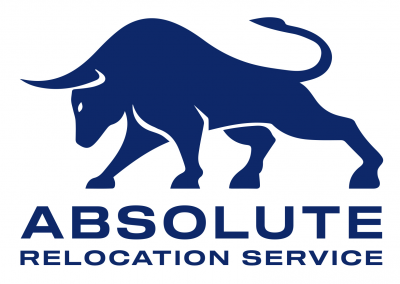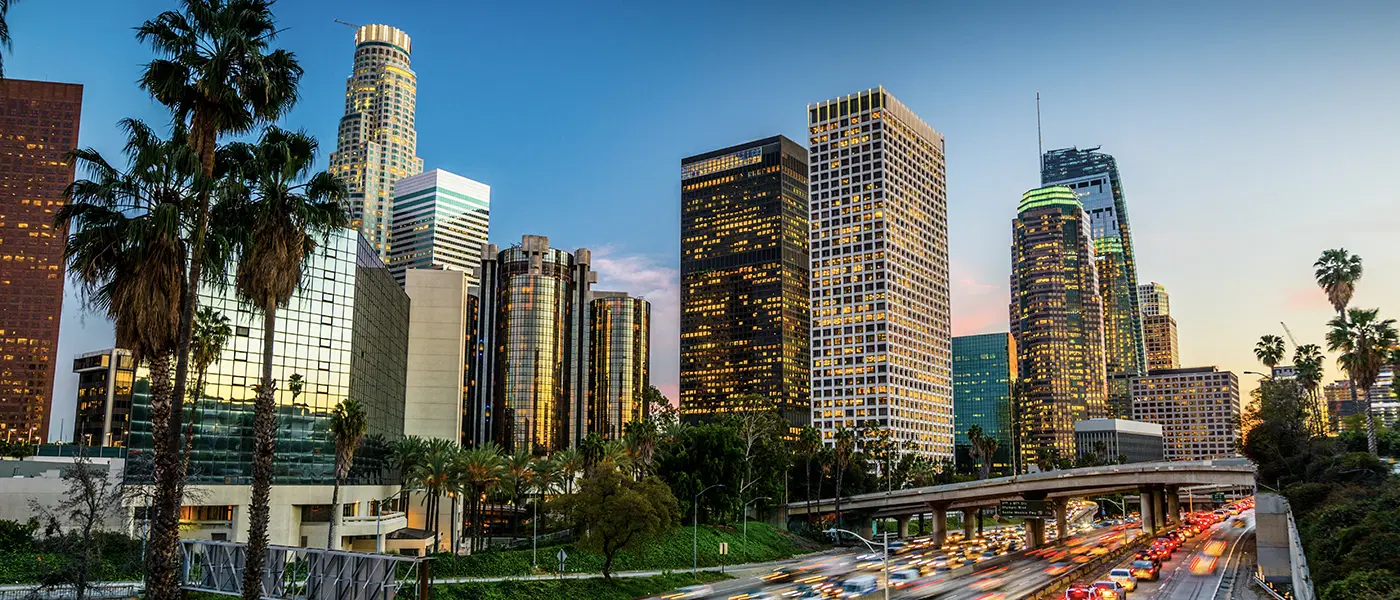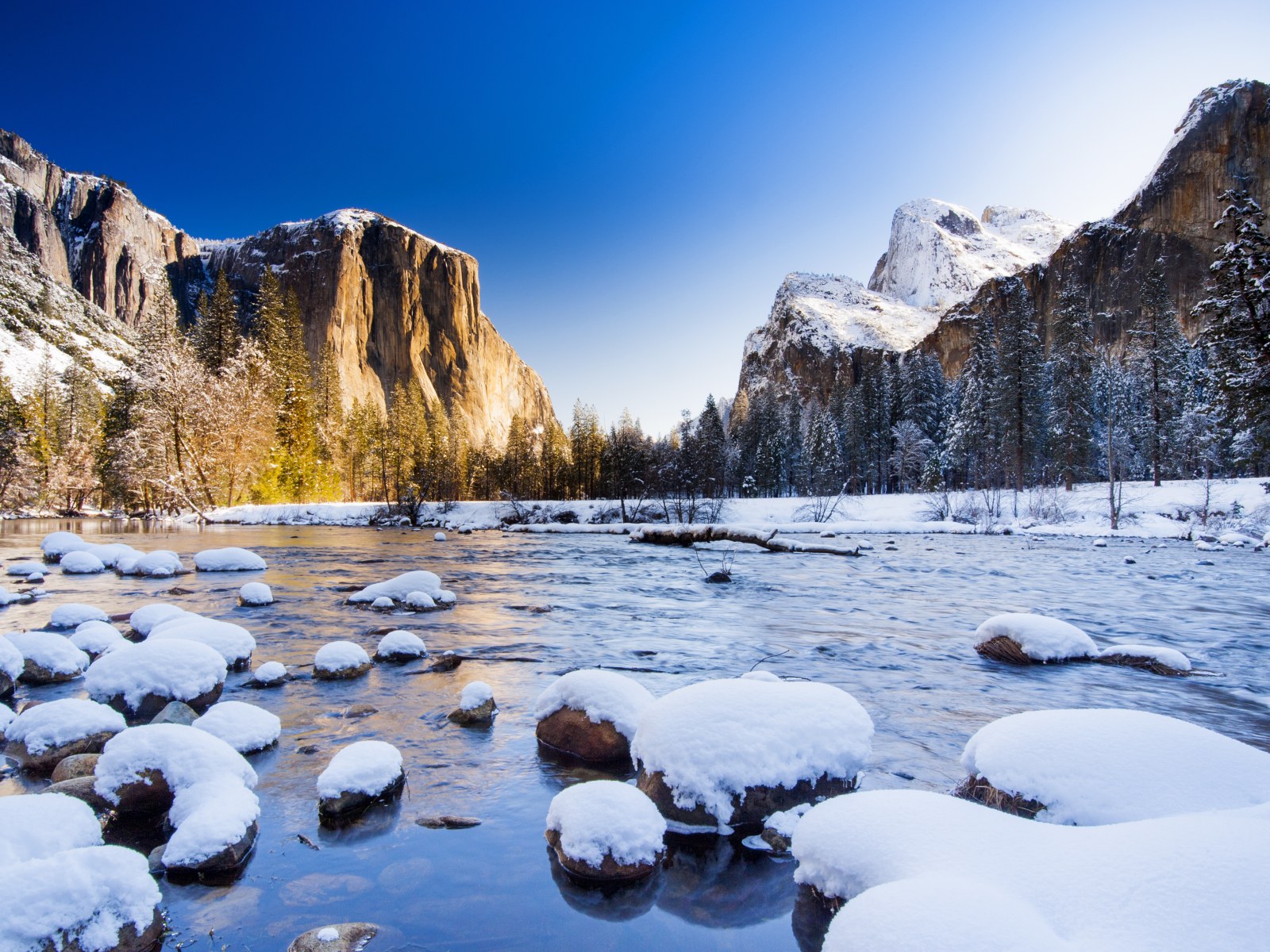California lifestyle: how the state’s cities differ and which one to choose for yourself
Moving to California is not only a choice of place to live, but also a choice of lifestyle. The state is known for its diversity: from the rich cultural life of large metropolitan areas to quiet coastal towns, from high mountains to unique desserts. In this article, we will analyze the features of the key cities in California and suggest which of them may be suitable for you to live comfortably.
1. Los Angeles: entertainment capital and cultural diversity
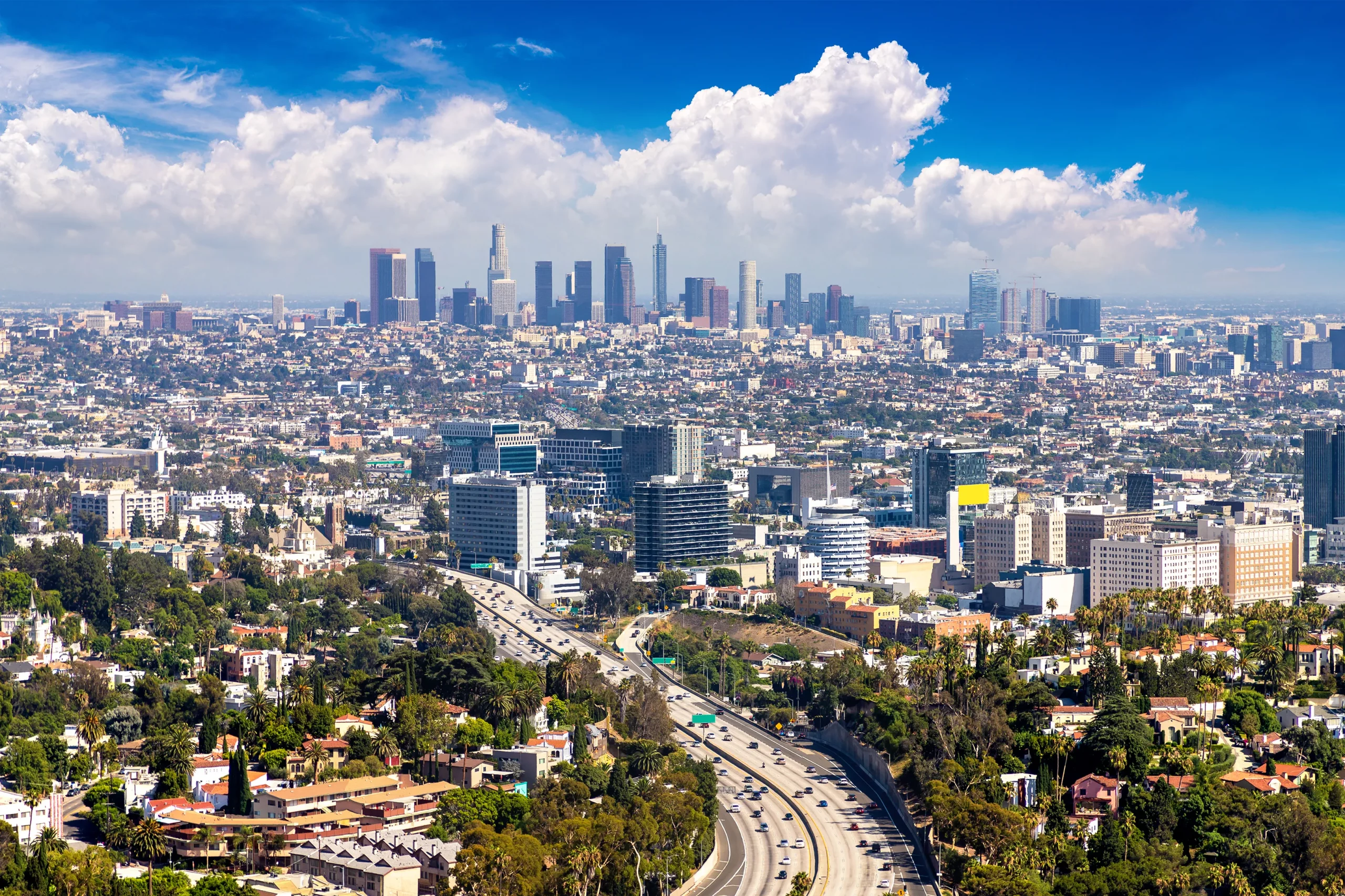
Los Angeles is a huge city with diverse neighborhoods where everyone can find a place to enjoy.
- Suitable for those seeking a career in the entertainment and media industry, who enjoy cultural events such as concerts, film festivals, exhibitions. The city also appeals to those who prefer a warm climate all year round.
- Life Features: Los Angeles is famous for its diverse cultural scene. People from all corners of the world can be found here, which gives the city a unique charm. There is a wide range of neighborhoods to choose from: Hollywood, Venice Beach, Santa Monica, Beverly Hills and others, each with its own character and lifestyle.
- Main disadvantages: High cost of living, high competition in the labor market and constant traffic jams.
Los Angeles is the second most populous city in the United States and one of the country’s largest economic and cultural centers. Located in southern California, Los Angeles attracts with its beaches, cinematic history and cultural diversity. The city offers many opportunities for career and personal growth, and its diverse neighborhoods provide a unique lifestyle for everyone.
Los Angeles is the world center for film and television and is known as the “entertainment capital of the world.” It is home to Hollywood movie studios including Paramount Pictures, Warner Bros., Universal Studios and others that open their doors for tours and shows. Hollywood Boulevard is home to the famous Walk of Fame and the TCL Chinese Theater, which hosts major movie premieres. The city also boasts many cultural institutions, including the Los Angeles County Museum of Art (LACMA), the Getty Center, and the Museum of Contemporary Art (MOCA), which offer extensive collections and world-class exhibitions.
Los Angeles is a city of contrasts and every neighborhood here is unique. Some of the most popular neighborhoods include:
- Hollywood: a famous neighborhood for movie lovers and tourists, offers many bars, restaurants and entertainment venues.
- Santa Monica: a coastal neighborhood with gorgeous beaches and a famous pier with rides and restaurants.
- Venice Beach: another popular beach neighborhood known for its skateparks, street performers and artistic atmosphere.
- Beverly Hills: a fashionable neighborhood with luxury mansions, upscale shopping on Rodeo Drive and exclusive restaurants.
- Downtown Los Angeles (DTLA): the cultural and financial center of the city, where you can find many skyscrapers, restaurants, clubs and cultural venues such as the Walt Disney Concert Hall.
Los Angeles is known for its mild Mediterranean climate. Sunny days year-round and the absence of snowy winters make it attractive to those who prefer warm weather. The city is surrounded by natural beauty, from the Pacific Coast and Santa Monica beaches to the San Gabriel Mountains, which offer opportunities for hiking, camping, and other outdoor activities.
Los Angeles offers many career opportunities, especially for those working in the film, music, fashion, and health, finance, and technology industries. In addition to major movie studios, startups are active in the city, and large corporations such as SpaceX, Google, and Amazon all have offices in the area.
- Film and Television: For those interested in careers in the film, television and music industries, Los Angeles is one of the best places to start and develop a career.
- Technology: The Playa Vista area, also known as “Silicon Beach,” is home to the offices of companies such as Google, Facebook and Yahoo, making it attractive to IT professionals.
- Fashion and Design: Los Angeles is one of the leading fashion centers in the US. It is home to fashion weeks, many boutiques, design studios and popular showrooms.
Traffic congestion is one of the biggest problems in Los Angeles. The city is vast and distances between neighborhoods are often long, making the car the primary mode of transportation. Despite this, the city has invested heavily in public transportation in recent years. The Los Angeles subway, bus network and bikeway network are becoming increasingly popular, although far from providing complete comfort.
Los Angeles is one of the most expensive cities in the United States. The average rent here is higher than in most other American cities, especially in popular neighborhoods such as Santa Monica, Venice Beach and Hollywood. High prices also apply to everyday expenses such as groceries, restaurants, and leisure activities. Living comfortably in Los Angeles will require a higher income than other regions of California and the United States.
Los Angeles is famous for its gastronomic diversity. Cuisines from all over the world can be found here, from Mexican and Korean to French and Mediterranean. The K-Town (Koreatown) neighborhood is known for Korean restaurants and barbecue, East LA offers traditional Mexican cuisine, and Little Tokyo offers Japanese cuisine. Also popular in the city are farmers’ markets, such as the Original Farmers Market on Third Street, where you can purchase farm-fresh produce.
Los Angeles offers many educational opportunities. It is home to major universities such as the University of California at Los Angeles (UCLA), the University of Southern California (USC), and the California Institute of the Arts (CalArts). The city also offers a wide variety of private and public schools. When it comes to healthcare, Los Angeles has some of the best hospitals and medical centers in the country, such as Cedars-Sinai and UCLA Medical Center, which provide high-quality medical services.
Los Angeles is a city that combines everything: career opportunities, cultural diversity, a warm climate, and an affluent lifestyle. However, the high cost of living and transportation difficulties are factors to consider when moving to the “City of Angels.” This city will suit those who are ready for an active life, value career advancement and enjoy cultural diversity.
2. San Francisco: technology center and startup culture

San Francisco is known as one of the world’s largest centers of technology and innovation. Its atmosphere combines old architecture with new buildings of startups and offices of tech giants.
- It is suitable for those who work in IT and technology or are looking to pursue a career in this field. The city will also appeal to those who enjoy European style and cultural events.
- Life Features: San Francisco is a city with rolling hills, beautiful views and a well-developed transportation infrastructure. It is considered one of the most tolerant and cosmopolitan places, which attracts people of different ages and nationalities.
- Main disadvantages: Very high cost of living and housing, intense competition for jobs, harsh winter winds and frequent rains.
San Francisco is one of the most beautiful and unique cities in the United States, located on the west coast of California. Known for its rolling hills, Golden Gate Bridge, architecture and cultural life, San Francisco is an important economic, cultural and tourist center. Despite its small size, the city occupies a significant place on the map of not only California but also the world.
San Francisco is a city where you can find something interesting at every step. Its attractions make it one of the most visited places in the US.
- Golden Gate Bridge: One of the modern wonders of the world, a symbol of the city and all of California. The bridge attracts tourists with its unique design and breathtaking views of the bay.
- Alcatraz Island: A famous prison that hosted prisoners like Al Capone. It is now a museum that can be reached by ferry and learn more about the dark history of the place.
- Fisherman’s Wharf: A tourist area with restaurants, stores, street performers and the popular Pier 39 where you can see harbor seals.
- Chinatown: One of the oldest and largest Chinatown outside of Asia, where you can immerse yourself in Asian culture, sample authentic Chinese cuisine and visit local markets.
- Haight-Ashbury: A historic neighborhood known as the center of the counterculture and hippie movement in the 1960s. Today, it’s full of stores, cafes and music clubs that retain the atmosphere of those years.
San Francisco is divided into many neighborhoods, each with its own atmosphere and offering different lifestyles:
- South of Market (SoMa): A modern business district with lots of offices for startups and companies like Twitter and Salesforce. It’s also home to many museums and restaurants.
- Mission District: Historic Hispanic neighborhood known for its street culture, street art and Mexican restaurants. Suitable for those looking for a creative and authentic atmosphere.
- Marina District: A tranquil bayfront neighborhood overlooking the Golden Gate Bridge, popular with young professionals and families.
- Pacific Heights: Prestigious neighborhood with luxury homes offering panoramic views of the city and bay.
- Richmond & Sunset: More affordable neighborhoods where you can find moderately priced housing, though there are also plenty of restaurants and parks.
San Francisco is part of Silicon Valley, and many tech companies choose to have offices here. The city is known for technology and IT startups and companies, which attracts professionals from all over the world.
- Technology and Startups: Companies such as Salesforce, Twitter, and Uber are located in the city. Apple, Google, Facebook and other tech giants have offices near San Francisco.
- Financial Industry: The city used to be the center of the west coast financial industry and is still home to offices of major banks and investment companies.
- Biotechnology: Due to its proximity to leading universities and research centers, the biotechnology industry is actively developing here.
San Francisco offers some of the best educational and medical facilities.
- Universities: The city is home to the University of California San Francisco (UCSF), one of the leading medical research centers in the United States, and the University of San Francisco (USF).
- Schools and Courses: High quality public and private schools are available for children and adults, as well as training centers offering continuing education programs.
- Health: San Francisco is home to leading medical facilities such as UCSF Medical Center and Kaiser Permanente, providing high quality medical care.
The city’s traffic congestion and complex transportation network are frequent challenges for residents. Despite this, San Francisco’s transportation system is considered one of the most convenient in California.
- Muni: A network of streetcars, buses and subways that covers most of the city and is convenient for daily commuting.
- BART: A commuter subway system that connects San Francisco to the East Bay neighborhoods and provides convenient access to the airport.
- Cable Cars: This historic mode of transportation has become a symbol of the city and is especially popular with tourists.
- Bicycles and Walking: San Francisco supports active transportation, and many residents choose to get around the city by bicycle or on foot.
San Francisco is one of the most expensive cities in the world. The high cost of real estate and renting is due to high demand and limited space within the city limits.
- Renting and buying a home: The average cost of renting an apartment is several thousand dollars a month, making San Francisco not affordable for everyone. Buying a home is also extremely expensive, especially in popular neighborhoods.
- Meals and everyday expenses: San Francisco is characterized by high food and restaurant costs, as well as high sales taxes. All of this makes living here financially demanding, especially for young professionals.
San Francisco has a mild climate, but is quite cool even in summer due to the fogs that come from the ocean side. Temperatures usually do not exceed 25°C in summer and rarely drop below 8°C in winter.
- Natural Areas: The nature around San Francisco is unique. In addition to central parks such as the Golden Gate, nearby national parks, the Pacific coast and the Napa and Sonoma wine valleys are ideal for recreation and travel.
- Environment: The city actively supports environmental initiatives, including recycling and promoting electric cars, making it one of the greenest cities in the United States.
San Francisco is famous for its culinary scene and variety of restaurants offering dishes from all over the world. You can enjoy fresh seafood, California cuisine, Mexican, Chinese, Japanese and other culinary masterpieces.
- FarmersMarkets: There are many markets in the city, such as the Ferry Plaza Farmers Market, where you can buy fresh local produce and gourmet goods.
- National Cuisine Neighborhoods: Chinatown, Mission District and Japantown offer a wide variety of authentic restaurants.
San Francisco is a city that offers unique opportunities and lifestyle, but requires a high level of financial preparation and adaptation to the climate and transportation system. If you’re looking for career opportunities in technology, cultural diversity, and an active city life, San Francisco may be the perfect place to relocate.
3. San Diego: a coastal paradise with a mild climate

San Diego, located in southern California, is known for its gorgeous beaches, national parks, and mild climate. It is a popular place to relocate among families and those who prefer a relaxed pace of life.
- Suitable for those looking for a balance between urban infrastructure and beach lifestyle, who want to live close to the ocean and live an active lifestyle in nature.
- Living Features: San Diego has a relaxed atmosphere, a rich beach culture, and plenty of restaurants and coffee shops. It also has a strong military community, as the U.S. Navy and Marine Corps are based in the city.
- Major cons: Despite relatively affordable prices compared to Los Angeles, housing is still expensive, especially in popular coastal neighborhoods.
San Diego, located in southern California near the Mexican border, is known for its mild climate, beaches and cultural diversity. It is the second largest city in the state and attracts those who appreciate the balance between an active lifestyle and the tranquility of a coastal city. With its economic development and recreational opportunities, San Diego is a popular place to live, work and travel.
San Diego is a paradise for beach lovers and outdoor enthusiasts.
- Beaches: The city offers more than 70 miles of beaches, including well-known spots such as Coronado, La Joya and Point Loma. La Joya’s beaches are popular with surfers and divers, while Coronado, with its famous Hotel del Coronado, attracts tourists and residents for its beauty.
- Hiking trails and parks: Balboa Park is one of the largest city parks in the United States with over 1,200 acres of green space, museums, theaters and the famous San Diego Zoo. The city also has hiking and camping trails, such as at Torrey Pines Nature Park, which offers ocean views and relic Torrey pines.
San Diego is a city with distinctive neighborhoods, each offering a unique living experience.
- Downtown San Diego: The modern downtown area is home to business centers, restaurants, nightlife and shopping. The Gaslamp Quarter neighborhood is especially popular for its restaurants, bars, and cultural events.
- La Joya: This prestigious coastal neighborhood is known for its luxury homes, elite schools and beaches. La Jolla is also a center for arts and sciences due to the presence of the University of California, San Diego (UCSD).
- Mission Beach and Pacific Beach: Youthful neighborhoods where an active beach culture prevails. Bars, restaurants, and entertainment venues can be found here, and surfing and other water sports can be enjoyed.
- North Park and South Park: These historic neighborhoods are known for their creative spirit and are home to numerous cafes, stores, galleries and parks. A great choice for those looking for a more bohemian and laid-back lifestyle.
- Coronado: An island neighborhood with a small population that is known for its beaches, charming streets and upscale apartment buildings. Coronado attracts both tourists and those who want to live in a quiet and exclusive part of the city.
San Diego has a vibrant economy in industries such as technology, defense, biotechnology, and tourism.
- Defense Industry: The San Diego Naval Base is the largest base of the U.S. Navy and has a huge impact on the city’s economy, creating many jobs in both military and civilian sectors.
- Technology and Biotechnology: With major science centers such as the University of California San Diego and many research institutes, the city has become a center for biotechnology and pharmaceuticals. Startups are also opening up in San Diego, which attracts many IT professionals.
- Tourism: Tourism is one of the major industries of San Diego. The city attracts millions of tourists every year with its beaches, parks, zoo and cultural events.
San Diego offers high-quality educational institutions and medical services, making it attractive to families and professionals.
- Universities: It is home to major universities such as the University of California, San Diego (UCSD) and San Diego State University (SDSU), which provide a high level of education and offer many programs in science, engineering, medicine and business.
- Medical Centers: San Diego is also known for its high-quality medical services, such as UCSD Medical Center and Scripps Health, which offer a wide range of specialized medical services.
San Diego’s transportation system includes buses, streetcars, and light rail. San Diego Municipal Airport is located just a few miles from the center, making it one of the most accessible airports in the country.
- Streetcars and Buses: The local MTS system offers streetcars and buses that cover much of the city and suburbs.
- Light Rail and Amtrak: The Trolley light rail line is convenient for traveling through urban areas, and Amtrak intercity trains provide easy access to other California cities.
- Walking and Biking: San Diego is a city that encourages walking and biking. Many neighborhoods, such as La Jolla and Coronado, are set up for walking.
San Diego is known for its high cost of living, especially in popular coastal neighborhoods. The average cost of renting a home is well above the U.S. average.
- Renting and buying a home: The average cost of renting an apartment in San Diego can be as high as $2,500 for a one-bedroom apartment in the center. However, the cost of buying a home is also high, making San Diego not affordable for everyone.
- Everyday Expenses: Prices for groceries, restaurants, and entertainment are higher than the national average. Residents also face high taxes, including property taxes.
San Diego is known for its mild and stable climate. Winters are warm and summers are cool, thanks to the influence of the Pacific Ocean. Temperatures rarely drop below 10°C in winter and above 30°C in summer, making for a comfortable living environment.
- Fogs and Humidity: Fogs may occasionally occur along the coast, especially in the morning, but they usually dissipate quickly.
- Dry Season: San Diego has virtually no cold winters, and the rainy season usually lasts from November through March.
San Diego offers a diverse culinary scene based on Mexican and Californian influences.
- Restaurants and cafes: San Diego offers everything from Mexican and Asian cuisine to modern fusion restaurants. Popular neighborhoods like Little Italy and Gaslamp Quarter are famous for restaurants and bars.
- Local Festivals: The city is known for annual events such as San Diego Beer Week and Comic-Con that attract tourists and residents.
- Breweries and Wineries: San Diego is one of the centers of craft brewing in the United States, and there are many local breweries offering unique brews to visit.
San Diego combines the advantages of a major city and a coastal resort, offering a mild climate, developed infrastructure, diverse career opportunities and a rich cultural life. The city is suitable for those who seek an active and comfortable lifestyle in a warm climate, are willing to pay for a high standard of living and enjoy the natural beauty of southern California.
4. Sacramento: Affordable Living in the State Capital

Sacramento, the capital of California, is less well known among tourists, but it is a dynamic city with a diverse culture and more affordable housing prices.
- Suitable for those looking for a quiet place to live with affordable housing and don’t mind the hot summers.
- Living Features: Sacramento is a mix of older neighborhoods and new business centers that are developing around the state government headquarters. The city is close to wine regions and nature, making it attractive to those who love nature and are into eco-gastronomic tourism.
- Main Cons: Sacramento can get very hot in the summer, and the city doesn’t offer the same variety of career opportunities as Los Angeles or San Francisco.
Sacramento, the capital city of California, is known for its historic roots, strong cultural scene, and affordable standard of living compared to coastal cities in the state. Although it is smaller and quieter than metropolitan areas such as Los Angeles or San Francisco, Sacramento attracts residents due to its lower housing costs, good amenities for families, developed infrastructure, and unique cultural environment.
Sacramento holds an important place in California history. This city became a center during the Gold Rush and still preserves many historical sites and monuments, which gives it a unique flavor.
- Old Town Sacramento: A historic district that preserves 19th century buildings. It is a popular place for walkers and tourists with museums, gift shops, and Wild West style restaurants.
- California State Capitol: The central building of the government complex where California’s government meets. The Capitol and its surrounding parks are open to the public and host tours and cultural events.
- Cultural Events: Sacramento hosts numerous festivals and events such as the Sakura Festival, the Raley Field Music and Culture Festival, and the Farm-to-Fork culinary festival highlighting the local agricultural heritage.
Sacramento offers a variety of lifestyles and housing types, from historic buildings to modern complexes and suburban homes.
- Midtown: A young and creative neighborhood, the center of urban life, where trendy cafes, restaurants, bars and stores are concentrated. It hosts numerous art events, exhibitions and concerts.
- East Sacramento: A quieter neighborhood with green streets and cozy homes. It is home to beautiful mansions and parks, as well as the famous “Fab 40s,” a street with luxury homes built in the 1920s.
- Natomas: A suburban neighborhood north of downtown that is popular with families for its affordable housing and good schools.
- Elk Grove: A southern suburb of Sacramento known for spacious homes, shopping centers and good schools. Suitable for those who prefer a quiet life in a family atmosphere.
Sacramento has a diversified economy, and while it has fewer tech companies than Silicon Valley, it offers good job opportunities in government, education, health care, and agriculture.
- Public Sector: Sacramento is the capital of California, so there are plenty of public sector jobs, from government work to administrative and management positions.
- Medical and Education: With the University of California at Davis and several major hospitals, including Sutter Health and Dignity Health, there is a high demand for health care and education professionals.
- Agriculture: Sacramento is surrounded by Central Valley farmland, making it a center for agribusiness and providing jobs in that field as well as in food and beverage production.
Sacramento offers quality education and health care, making it attractive to families.
- Universities: The University of California, Davis (UC Davis), located just 20 minutes from Sacramento, is one of the leading universities in agriculture, biotechnology and medicine. The city also has Sacramento State University (Sacramento State).
- Schools: Suburban neighborhoods such as Elk Grove and Natoma are home to quality elementary and middle schools that are highly regarded by locals.
- Medical Facilities: The medical infrastructure is represented by several major hospitals and medical centers, including Sutter Medical Center and UC Davis Medical Center.
Sacramento has a well-developed transportation system, making it convenient for living and working.
- Freeway Connections: The city is located at the intersection of major highways, making it easily accessible to other cities in the state, including San Francisco and Los Angeles.
- Public Transportation: Sacramento offers bus and streetcar routes through the Sacramento Regional Transit system that cover most areas of the city. However, like other California cities, traveling by car is popular here.
- Rail and Airport: Amtrak provides intercity rail routes connecting Sacramento to other cities. Sacramento International Airport is just 15 minutes from the city center and serves both domestic and international flights.
Unlike San Francisco or Los Angeles, Sacramento offers more affordable housing, making it attractive to those who want to live in California but are not willing to pay high real estate prices.
- Renting and buying a home: On average, renting an apartment here will cost significantly less than in major California metropolitan areas. Buying a home is also more affordable, especially in suburbs like Elk Grove or Natoma.
- Daily Expenses: Prices for food and daily necessities are also lower compared to coastal cities, making the city attractive from a financial standpoint.
Sacramento is known for hot, dry summers and mild, rainy winters, making it suitable for those who prefer a warm climate.
- Summer: Summer temperatures can reach 35-40°C, so many residents prefer to spend this time by the rivers and lakes where they can cool off and relax.
- Winter: Winter is mild, with temperatures around 10-15°C. The main precipitation falls in the winter, and the city is virtually snow-free.
Sacramento offers a variety of entertainment, from cultural events to outdoor activities.
- Restaurants and Bars: The city is known as the center of the farm-to-fork movement, which means that many restaurants offer dishes made from local farm products. Restaurants and cafes in the Midtown and Downtown neighborhoods are especially popular.
- Parks and Outdoor Recreation: The city is located near lakes and rivers, such as the American River, where you can go kayaking, fishing, and biking. There are also many parks within the city limits, including McKinley Park and Land Park.
- Proximity to Natural Attractions: Sacramento is conveniently located for traveling to the Sierra Nevada Mountains for winter sports, hiking and visiting Lake Tahoe.
Sacramento is a city with a rich history, an active cultural scene, and a more affordable living environment than many other California cities. With its warm climate, moderate housing prices and convenient proximity to a variety of natural attractions, Sacramento is becoming an increasingly popular destination for those who want to combine a relaxed lifestyle with big-city opportunities.
5. Santa Barbara: a picturesque city for beach and nature lovers
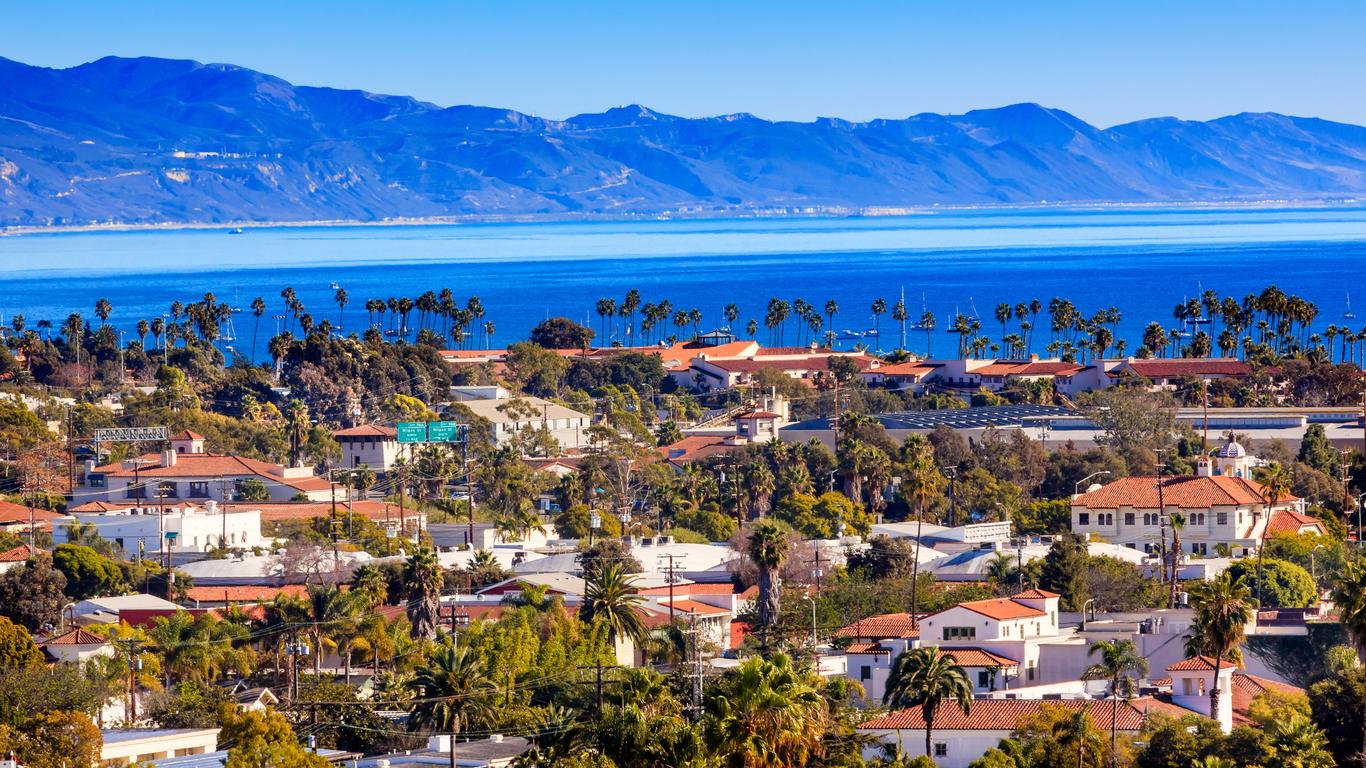
Santa Barbara is a small coastal city with luxurious views that is known for its laid-back atmosphere and quality of life. The city is often referred to as the “American Riviera” for its similarities to the Mediterranean coastline.
- Suitable for those who seek privacy, tranquility, want to live surrounded by nature and surf or do yoga on the beach.
- Living Features: Santa Barbara attracts with its natural beauty, cozy architecture and a sense of quietness. The city is popular with affluent people seeking privacy and luxury.
- Main disadvantages: Housing costs are high and employment opportunities are limited, with most jobs in the tourism and service industries.
Santa Barbara, located on the coast of southern California, combines a Mediterranean climate, picturesque beaches and cultural heritage. This charming city attracts those who want to enjoy warm weather, Spanish-style architecture and a relaxed yet elegant lifestyle. Known as the “American Riviera,” Santa Barbara combines the resort town style and amenities of a developed center with a unique cultural atmosphere and diverse recreational opportunities.
Santa Barbara stands out from other California cities with its unique style and architecture inspired by its Spanish colonial past.
- Spanish architecture: The city retains many of the features of its colonial past, with white-washed buildings with tile roofs, arches, and Spanish Renaissance decorations. Landmarks such as the Santa Barbara Courthouse, with its murals and observation tower, are architecturally valuable and offer magnificent views of the city and ocean.
- Historical Attractions: Mission Santa Barbara, founded in 1786, houses a museum highlighting the region’s history and indigenous culture. It is one of the best-preserved missions in California that is still in operation and open to the public.
- Museums and Galleries: The Santa Barbara Museum of Art and the Maritime Museum present exhibitions on culture, nature and art. Local art galleries and workshops are also popular and are often open for tours and exhibitions.
Santa Barbara attracts residents and tourists alike because of its cozy neighborhoods, each with its own atmosphere and unique features.
- Downtown: Santa Barbara’s historic downtown is known for its many restaurants, cafes, stores and galleries. The main street, State Street, is a lively place to stroll with a wide variety of restaurants, from local to upscale.
- Monte Cito: This is Santa Barbara’s upscale neighborhood known for its luxury homes, gated clubs, and magnificent ocean views. Monte Cito attracts the wealthy, including celebrities, and is considered one of the most expensive neighborhoods in the region.
- La Mesa and Riviera: Picturesque rolling hills with beautiful ocean and city views. These neighborhoods are popular with those who appreciate quiet and privacy but want to stay within the city limits.
- Funk Zone: A creative and vibrant neighborhood close to the coast. A variety of restaurants, craft breweries, bodegas and art galleries can be found here. “Funk Zone” is particularly popular with young people and creative professionals.
Santa Barbara’s economy is based on a combination of industries including tourism, health care, education, and agriculture.
- Tourism: Santa Barbara attracts thousands of tourists each year, and the hospitality industry plays a key role in the economy. There are numerous hotels, resorts, and restaurants that offer a variety of job opportunities.
- Health and Education: The city is home to the University of California, Santa Barbara (UCSB), a major educational and research center that attracts students and professionals from around the world. In addition, the health care system is represented by major medical centers such as Santa Barbara Cottage Hospital.
- Agribusiness and winemaking: Santa Barbara is located in a region that is famous for its vineyards. Winemaking and agribusiness are actively developing in the county, providing jobs and creating conditions for the development of gastronomic tourism.
Santa Barbara offers quality education and top-notch medical facilities, making the city popular with families and professionals.
- Institutions of Higher Learning: The University of California, Santa Barbara (UCSB) is one of the nation’s leading research universities. It is also home to colleges and academies offering programs for students at all levels.
- Medical Centers: Santa Barbara Cottage Hospital and other medical facilities in the city provide high-level medical services, including specialty areas such as oncology and cardiology.
Santa Barbara has a good transportation system and is conveniently located for trips to Los Angeles and San Francisco.
- Intercity Transportation : The city is on the route between Los Angeles and San Francisco, and Amtrak rail service makes travel between the cities convenient and affordable.
- Local Transportation: Santa Barbara has bus routes, and many locals prefer to get around by bicycle due to the warm climate and convenient city infrastructure.
- Santa Barbara International Airport: Santa Barbara Airport offers flights to Los Angeles, San Francisco and other U.S. cities, providing convenient connections to major destinations.
Santa Barbara is one of the most expensive cities in California with high prices for renting and buying a home.
- Renting and buying a home : The average cost of renting a home here is much higher than the national average, and buying real estate is only available to the wealthy. The most upscale neighborhoods, such as Monte Sito, offer luxury homes and mansions, while more affordable housing can be found in the suburbs.
- Daily Expenses: The cost of living in Santa Barbara is also above average for groceries, restaurants, and services. However, the high standard of living is offset by the quality of education, medicine, and beautiful nature.
Santa Barbara is known for its Mediterranean climate with mild winters and warm, dry summers, making it a popular place to live and vacation year-round.
- Summer: Summers here are warm and dry, but the heat is mitigated thanks to ocean breezes. It’s the perfect time for beach vacations, walks and outdoor sports.
- Winter: Winter temperatures rarely drop below 10°C, making Santa Barbara an attractive year-round destination. Rain is also possible during this season, but it is rare.
Santa Barbara offers many opportunities for outdoor activities, cultural entertainment and gastronomic delights.
- Beaches: Santa Barbara’s beaches, such as East Beach and West Beach, are ideal for swimming, surfing and relaxing on the beach. In addition, the mild climate makes the beach season almost year-round.
- Hiking trails and wineries: Santa Barbara’s surrounding mountains and vineyards make for great hiking and tasting. Hiking trails such as Inspiration Point and Cold Spring Trail offer stunning views of the coast and valley.
- Cooking and Winemaking: Santa Barbara is known for its cuisine, particularly a restaurant scene focused on fresh, local produce. Farmer’s markets and restaurants offer dishes made with local vegetables, fruits, and seafood. The region is also known for its wineries and wine tours.
Santa Barbara is a unique city that combines natural beauty, historical heritage and an upscale lifestyle. With beautiful beaches, cultural events and a temperate climate, this city is suitable for both relaxed family life and those who appreciate an active lifestyle and nature.
6. Palm Springs: a desert oasis for active retirees and creative people
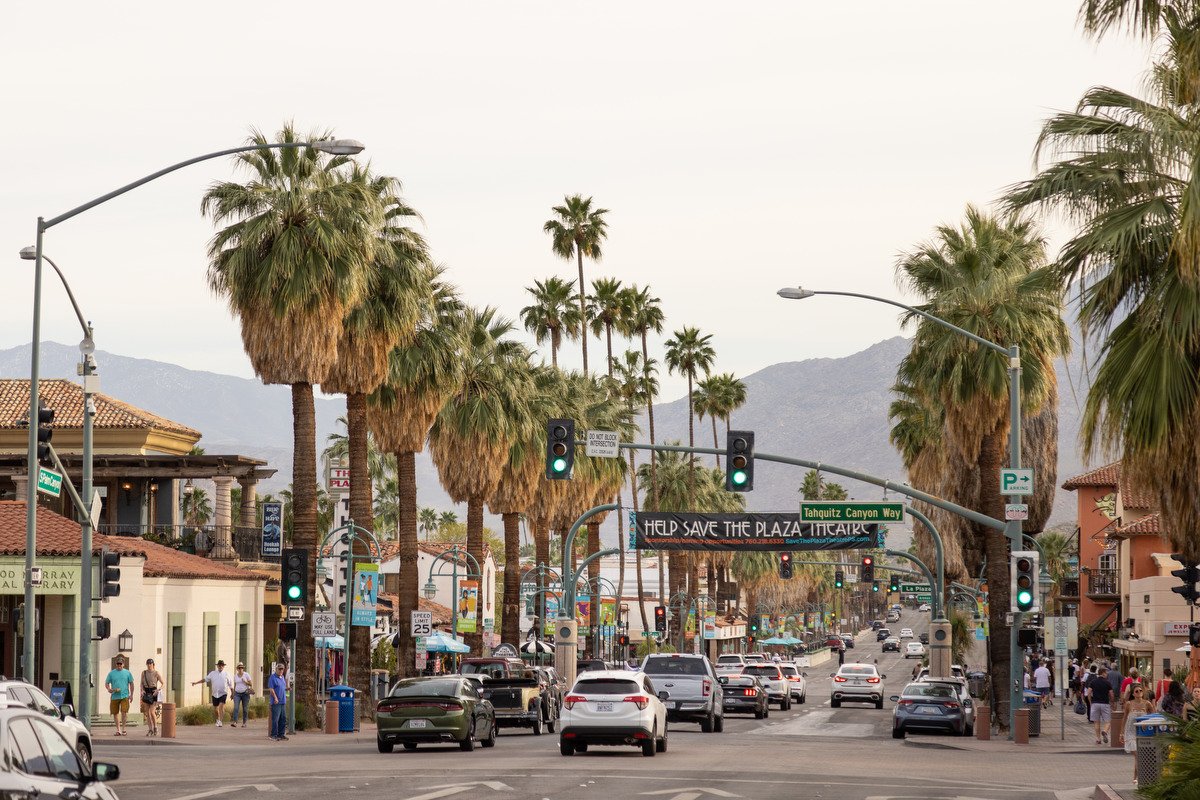
Palm Springs is a renowned desert resort town known for its warm climate, interesting architecture and active cultural life.
- Suitable for those looking for a warm climate and a relaxed pace of life or those planning to retire.
- Life Features: The city has many golf courses, parks, yoga and meditation centers, making it popular with older people. However, younger people also actively come here for the creative atmosphere and affordable housing.
- Major cons: Too hot in the summer, limited employment opportunities outside of the tourism and service industries.
Palm Springs, a resort town in California located in the Coachella Desert, is known for its hot sunny days, unique nature, and Mediterranean climate. This city attracts locals as well as tourists from all over the world with its spas, pools, and abundant outdoor activities. Palm Springs is also known for its mid-century culture, including mid-century modern architecture, and is a favorite destination for celebrities and those seeking a tranquil and luxurious atmosphere.
Palm Springs is one of the world capitals of mid-century modern architecture. In the 1950s and 60s, landmark buildings were constructed here that still give the city a unique and modern look.
- Mid-century modern: Palm Springs is home to homes and buildings with clean lines, flat roofs, wide glass facades and open floor plans. It was home to famous architects such as Richard Neutra and John Lothrop, who created modernist masterpieces including celebrity residences.
- Design Tours: The city runs architectural tours where you can tour iconic buildings and learn more about the design and history of local sites. During the annual Modernism Week festival, local and visiting architecture enthusiasts can attend workshops, lectures, and tours that focus on mid-century style.
Palm Springs offers a variety of activities to suit every taste, from natural beauty to exclusive spa treatments and gastronomic delights.
- Hot springs and spas: The city and surrounding areas are home to hot springs, making Palm Springs a popular destination for spa vacations. Many hotels and resorts offer mineral baths and healing treatments, appealing to those seeking tranquility and relaxation.
- Hiking trails and outdoor activities: Surrounded by the San Jacinto Mountains, Palm Springs provides excellent opportunities for outdoor activities. Routes such as Indian Canyons and Mount San Jacinto State Park offer scenic trails and unique desert views. These trails are ideal for hiking, hiking, and even rock climbing.
- Golf: The city is considered one of the best golf destinations in the world. There are over a hundred golf clubs and courses here, attracting both professionals and amateurs. The local courses combine comfortable infrastructure with desert and mountain views.
Palm Springs is known for its hot and sunny climate with over 350 days of sunshine a year. This place attracts those who prefer warm weather and are not afraid of heat.
- Summer: Summer temperatures can reach 40-45 °C and this time of the year is suitable for those who love the scorching sunshine and enjoy by the pool or in air-conditioned rooms.
- Winter: Winter temperatures are much lower and more comfortable, around 20-25 °C, making this time of year the most popular time to visit. During this season, the city attracts tourists fleeing the winter cold of other regions.
Palm Springs hosts numerous festivals and events that attract visitors and residents from all over the world.
- Palm Springs Film Festival: The Palms Springs International Film Festival brings together Hollywood stars and movie buffs at the beginning of every year. It is one of the largest film festivals in the United States and an important cultural event for the city.
- Coachella Festival: Although Coachella takes place in the neighboring city of Indio, it attracts many visitors to Palm Springs. It is the largest outdoor music festival featuring top artists and bands from around the world.
- Modernism Week: As mentioned, this event is for architecture and design enthusiasts and features lectures, tours, and special displays focusing on mid-century architecture.
Despite its small size, Palm Springs offers quality education and health services, making it an attractive place for families.
- Educational Institutions: The city operates elementary and middle schools, as well as institutions for higher education in neighboring communities. Palm Springs also offers programs and facilities for adults, including courses in art, language, and design.
- Medical Centers: Medical services in Palm Springs include specialty centers and major hospitals. Desert Regional Medical Center is one of the largest medical centers in the region, offering top-notch medical services.
Palm Springs real estate prices remain relatively affordable compared to the California coast, but have increased in recent years due to the high demand for resort housing.
- Real Estate Market: Palm Springs attracts real estate buyers looking for vacation homes, especially in retirement. Average home values are more affordable than larger cities in the state, but are increasing due to the region’s popularity with tourists.
- Rental Housing: Renting is also a popular option among tourists and temporary residents, and there are a wide range of choices from inexpensive apartments to luxury villas with a pool and garden. Rental costs vary depending on the neighborhood and season.
Each neighborhood in Palm Springs has its own distinct character and has something unique to offer residents and visitors.
- Downtown Palm Springs: The heart of the city, home to many restaurants, boutiques, galleries and cafes. It is also home to hotels and resorts offering excellent service and vacation amenities.
- Vista Las Palmas: One of the most prestigious neighborhoods in Palm Springs, featuring luxury homes and residences in mid-century architectural style. This neighborhood is popular with wealthy buyers and celebrities.
- Arocho Mirage: This is one of the city’s greenest and most prestigious neighborhoods, located slightly north of downtown. It has numerous golf courses and luxury villas.
- Indian Canyon and Movie Colony: These neighborhoods are known for their historic celebrity homes and quiet atmosphere. Residents here enjoy coziness and privacy surrounded by palm trees and golf courses.
Like any city, Palm Springs has its pros and cons that are important to consider when choosing a place to relocate.
Advantages:
- Excellent climate and plenty of sunny days
- Rich cultural and architectural life
- Quiet lifestyle and proximity to natural attractions
- Lots of opportunities for outdoor activities and sports
Disadvantages:
- Very hot summers when daytime temperatures can reach extremes
- Limited career opportunities, as the city’s economy is mainly dependent on tourism and the recreation industry
- High prices for recreation and entertainment due to the popularity of the region among tourists
Palm Springs is a desert oasis that attracts people from all over the world with its unique blend of natural beauty, architecture and cultural events. This city is perfect for those who want to enjoy the sun all year round, have an active lifestyle and appreciate a high level of comfort and a relaxed atmosphere.
7. Fresno: an affordable and fast-growing city in the Central Valley

Fresno is one of the most affordable major cities in California, located in the Central Valley, known for its agricultural products. It is a quiet place to live with relatively low housing costs.
- It is suitable for those looking for affordable housing and a quiet life while still remaining in the center of the state.
- Living Features: Fresno is a major agricultural center that is also close to national parks such as Yosemite and Sequoia. The city is actively growing, and there are many universities and schools.
- Major cons: Economic opportunities are limited, and most jobs are concentrated in the agricultural and food processing industries. Temperatures can reach high levels in the summer, which adds to the discomfort.
Fresno, located in the heart of California’s Central Valley, is a dynamic city known for its agricultural potential, affordable standard of living, and growing cultural and economic opportunities. The fifth largest city in the state, Fresno is considered a great alternative to California’s more expensive and congested metropolitan areas. It is home to many parks, unique museums, and a variety of recreational activities, making it attractive to families and those seeking a balance between city life and proximity to nature.
Fresno is a center of agricultural production, and this sector remains the most important part of its economy.
- Agricultural Industry: The region is known as one of the leading agricultural areas in the United States. Almonds, grapes, oranges, and other products are grown here and exported throughout the country and beyond. The city is proud of its farming heritage, and this is felt in the variety of localized cuisine available at farmers markets.
- Farmers Markets and Gastronomy: Fresno hosts fairs and festivals dedicated to local produce. One such event is the Big Fresno Fair, which takes place every fall and brings together farmers, restaurateurs, and locals.
Fresno is surrounded by scenic natural areas and has many parks where residents can enjoy outdoor recreation.
- Woodward Park: One of the largest parks in the Central Valley, covering about 300 acres. It offers great facilities for hiking, biking, picnicking, and outdoor recreation. The park also includes Shinzen Japanese Garden, a Japanese garden known for its beauty and peaceful atmosphere.
- Roeding Park and Fresno Chaffee Zoo: Roeding Park is famous for its old growth trees and spacious green lawns. It is also home to the Fresno Chaffee Zoo, which is popular with families and offers sightings of different species of animals from around the world.
Fresno is committed to fostering cultural initiatives and the arts, offering many galleries, museums, and theaters.
- Museums and Galleries: The Fresno Museum of Art offers a rich collection of contemporary and classical works, sculpture and photography exhibitions. The city also has the Fresno Symphony Museum and the Calley History Museum.
- Musicals and Theaters: Downtown is home to the Tower Theatre, Fresno’s oldest and most famous theater. It hosts plays, musical performances and independent movie screenings. The Rogue Festival is held annually in April and offers theater and musical productions, as well as exhibits and performances.
Fresno is known for its educational institutions and the availability of professional education.
- University of California at Fresno: Fresno State University is the city’s leading university and one of the important academic centers in the Central Valley. It provides high-quality education in agronomy, business, education, and the arts.
- Job Availability: Agribusiness, health care, education, and service industries are major employment areas. The city is actively attracting new companies, which helps diversify the economy and create jobs.
Fresno offers relatively affordable housing, making it attractive to families and those looking to settle down in a quieter but affordable area of California.
- Affordable housing prices: Housing prices here are much lower than in major California cities such as San Francisco and Los Angeles. This allows young families and professionals to buy their own home or rent at a lower cost.
- Standard of Living : The relatively low cost of living in Fresno makes it attractive to those looking for stability. Costs for transportation, utilities, and food are also lower than other areas of the state.
Fresno is great for outdoor enthusiasts and provides quick access to some of California’s most beautiful natural parks.
- National Parks: Yosemite, Kings Canyon and Sequoia are all within a few hours of Fresno, making the city a great base for hikers and nature lovers.
- Festivals and Events: Fresno hosts colorful annual festivals such as Grizzly Fest, a music festival, and the Fresno County Blossom Trail, a spring festival where you can see orchards covered in peach and almond blossoms.
Fresno is located in a warm Mediterranean climate zone with hot summers and mild winters.
- Summer: Summers can be quite hot, with temperatures often exceeding 35 °C. However, the abundant sunshine attracts beach lovers and allows year-round access to water and sunbathing.
- Winter: Temperatures remain moderate during the winter months, rarely dropping below freezing, allowing you to enjoy the outdoors all year round.
Fresno has its own characteristics and, like any city, has advantages and disadvantages to consider before moving.
Advantages:
- Affordable housing prices and relatively low cost of living.
- Well-developed community, cultural activities and access to nature.
- Important agricultural and educational value, creating jobs and a sustainable economy.
- Proximity to national parks and natural areas.
Disadvantages:
- Summer heat can be challenging for many residents, especially when combined with a dry climate.
- Underdeveloped high-tech jobs and startups compared to larger cities.
- Some areas suffer from air pollution due to agricultural activities.
Fresno offers unique advantages for those seeking affordable housing, a stable economy and a relaxed lifestyle. The city provides a great environment for families, young professionals and those seeking a balance between work and outdoor recreation. With its combination of cultural opportunities and rich agricultural history, Fresno is an increasingly popular place to relocate and make a new home.
How do you choose a city to live in?
Moving to California is a big step, and choosing the right city is one of the keys to a comfortable adjustment. To figure out which city is right for you, assess your needs and preferences:
- Career goals: If you work in IT or entertainment, San Francisco, Los Angeles, or San Diego would be a good fit.
- Climate: For mild winters and hot summers, consider San Diego, Fresno or Palm Springs.
- Lifestyle: If you like a more relaxed, measured pace and proximity to nature, consider Santa Barbara or Sacramento.
- Budget: For those looking for an affordable place to live, Fresno and Sacramento are better suited for you, with lower prices than other California cities.
Every city in California is unique, and understanding your priorities will help you make the best choice.
Services of our moving company
Our moving company is ready to take care of all your moving needs. We offer a full range of moving services, including packing, transporting, and unpacking your belongings. Our team of professionals will ensure a safe and secure move so you can enjoy your new life in this beautiful state.
Contact us in any way:
Telephone: (888) 282-6940
